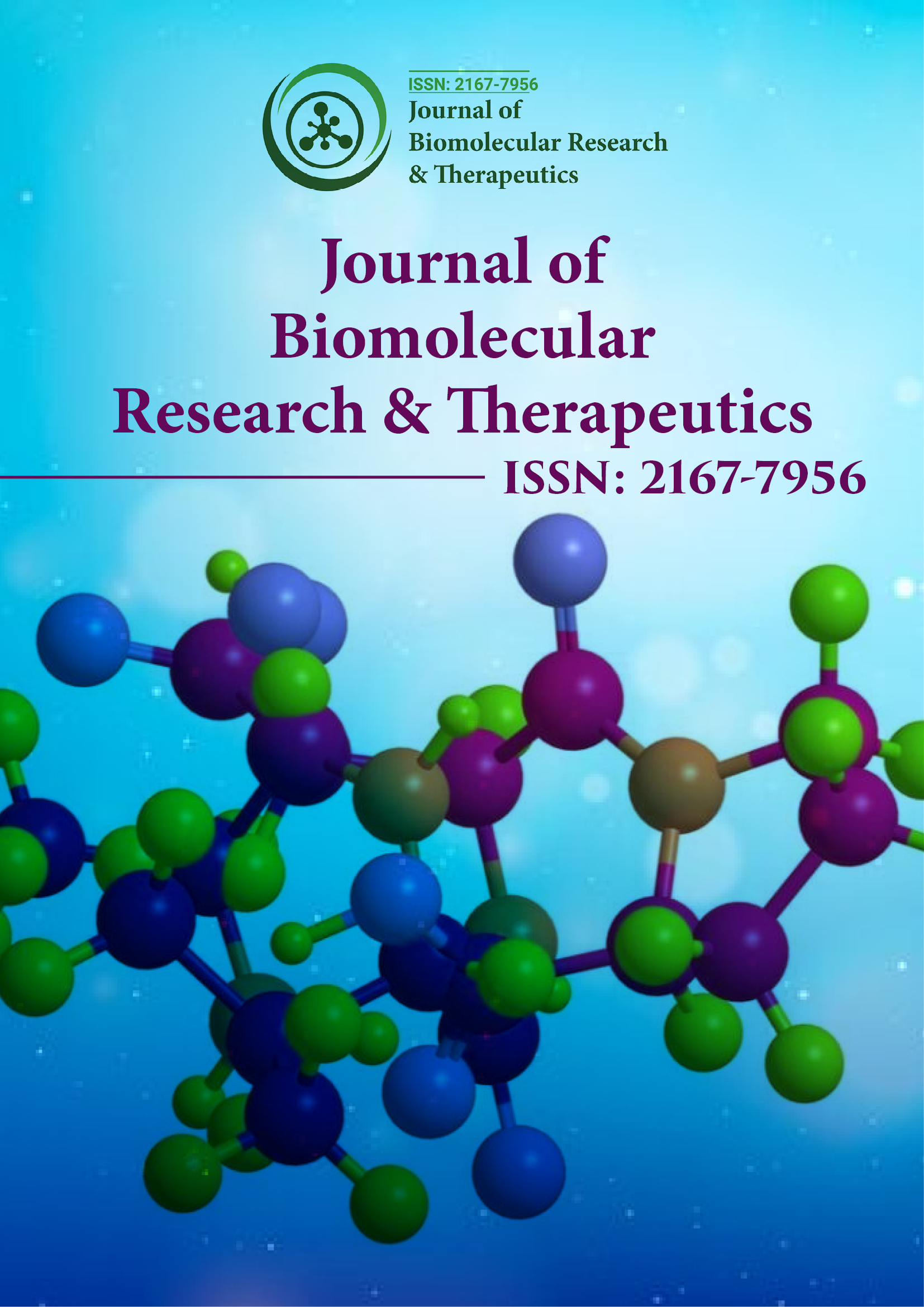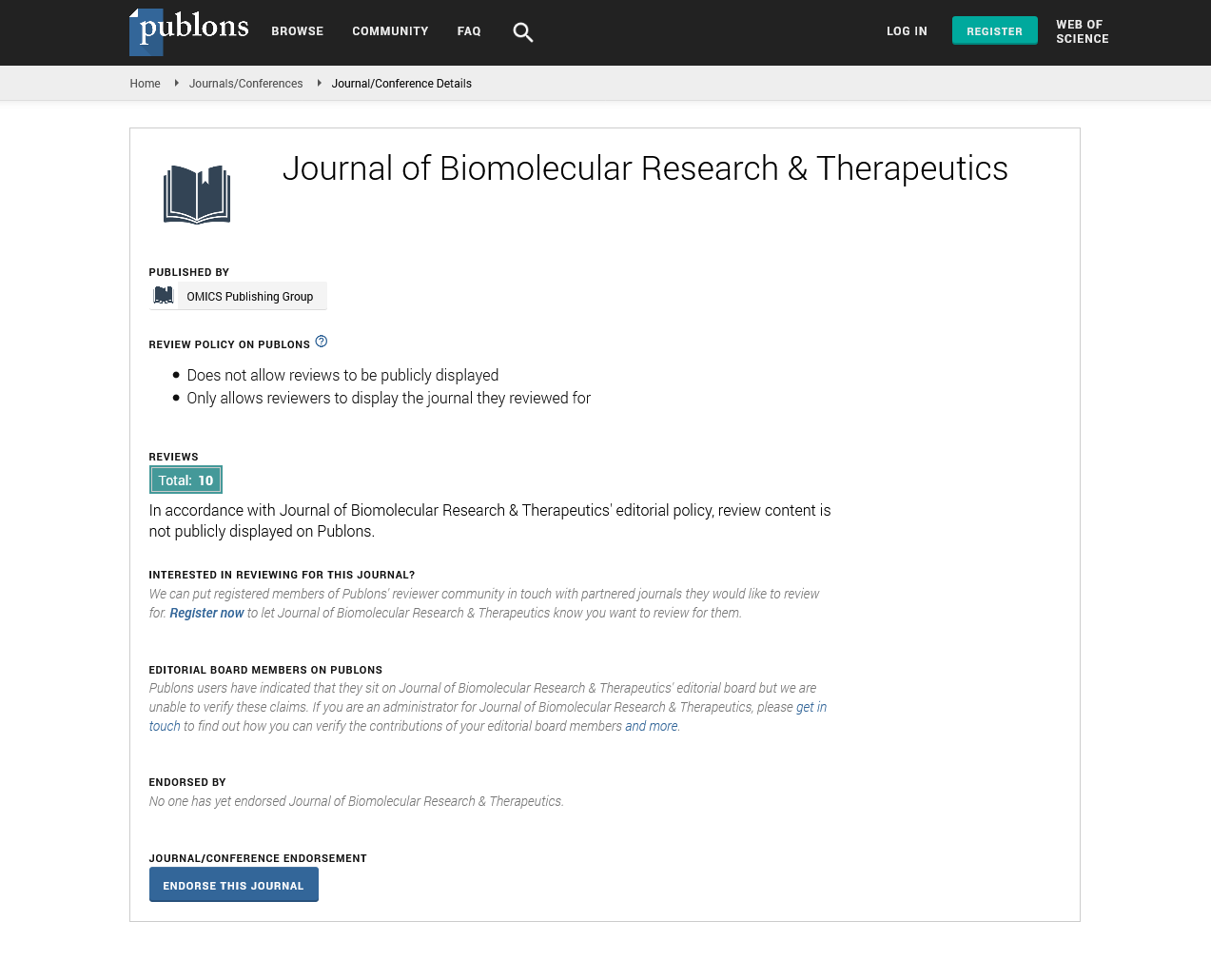Indexed In
- Open J Gate
- Genamics JournalSeek
- ResearchBible
- Electronic Journals Library
- RefSeek
- Hamdard University
- EBSCO A-Z
- OCLC- WorldCat
- SWB online catalog
- Virtual Library of Biology (vifabio)
- Publons
- Euro Pub
- Google Scholar
Useful Links
Share This Page
Journal Flyer

Open Access Journals
- Agri and Aquaculture
- Biochemistry
- Bioinformatics & Systems Biology
- Business & Management
- Chemistry
- Clinical Sciences
- Engineering
- Food & Nutrition
- General Science
- Genetics & Molecular Biology
- Immunology & Microbiology
- Medical Sciences
- Neuroscience & Psychology
- Nursing & Health Care
- Pharmaceutical Sciences
Commentary - (2024) Volume 13, Issue 5
The Role of Bioconjugation in Quantum Dots for Bioimaging and Beyond
Eleonora Jennings*Received: 30-Sep-2024, Manuscript No. BOM-24-27789; Editor assigned: 02-Oct-2024, Pre QC No. BOM-24-27789 (PQ); Reviewed: 16-Oct-2024, QC No. BOM-24-27789; Revised: 23-Oct-2024, Manuscript No. BOM-24-27789 (R); Published: 30-Oct-2024, DOI: 10.35248/2167-7956.24.13.407
Description
Quantum Dots (QDs) have emerged as efficient tools in modern science due to their exceptional optical and electronic properties. These nanoscale semiconductor crystals exhibit size tunable fluorescence, high quantum yield and excellent photostability, making them ideal for imaging, diagnostics and sensing applications. However, their integration into biological systems hinges on effective and stable bioconjugation strategies. Recent advancements in QD bioconjugation have addressed key challenges, unlocking new opportunities in biotechnology and medicine.
The primary challenge in QD bioconjugation lies in their hydrophobic surface chemistry. Synthesized through high temperature decomposition, QDs are typically capped with hydrophobic ligands like trioctylphosphine oxide, rendering them insoluble in water. To facilitate bioconjugation, these surfaces must be modified to introduce hydrophilic, biocompatible functional groups. This process ensures aqueous solubility while providing reactive sites for linking biomolecules such as antibodies, peptides, or nucleic acids.
Advances in surface engineering have significantly enhanced QD bioconjugation. Ligand exchange, a widely adopted method, replaces hydrophobic ligands with hydrophilic ones, such as thiolated Polyethylene Glycol (PEG) or zwitterionic ligands. These ligands improve water solubility, reduce nonspecific binding and enhance stability. Additionally, polymer coatings that stabilize QDs while offering a range of functional groups have enabled multivalent and multifunctional modifications.
Covalent bioconjugation techniques have advanced, providing robust linkages between QDs and biomolecules. Functional groups like carboxylic acids, amines and thiols facilitate stable covalent bonds through chemistries such as carbodiimide coupling and maleimide-thiol reactions. These approaches ensure durability under physiological conditions, preserving QD functionality. Bioorthogonal chemistries, including click reactions and strain-promoted cycloadditions, offer exceptional specificity, enabling efficient QD-bioconjugate synthesis without interfering with biological systems.
Non-covalent methods have also evolved, offering alternative approaches to QD functionalization. Electrostatic interactions, hydrophobic forces and affinity-based binding, such as biotin-streptavidin coupling, provide flexible options for conjugation. These methods are particularly advantageous for applications requiring reversible or dynamic interactions. DNA-directed assembly has gained traction as a precise strategy, leveraging complementary DNA strands to achieve programmable architectures for QD-bioconjugates.
Emerging biomolecular tools like single-domain antibody fragments (nanobodies) and aptamers have further advanced QD bioconjugation. Their small size and high affinity make them ideal for creating QD conjugates with enhanced specificity, particularly in biosensing and targeted imaging applications. The use of lipids and carbohydrates in QD bioconjugation has also broadened the scope of their application, enabling incorporation into lipid bilayers and glycan-targeting systems. These advancements have expanded the utility of QDs in studying cellular membranes, glycobiology and other complex biological systems.
Bioimaging remains one of the most transformative applications of QD bioconjugation. Fluorescent QDs conjugated with targeting ligands enable high-resolution visualization of dynamic processes in living cells. Their superior brightness and photostability compared to traditional fluorophores allow extended imaging sessions without significant signal loss. In vivo imaging has also benefited, with QD conjugates enabling precise detection of biomarkers and tumor cells. These advancements have facilitated groundbreaking research in cellular biology and disease mechanisms.
In diagnostics, QD-bioconjugates have significantly improved assay sensitivity and accuracy. Conjugation with antibodies or nucleic acids allows QDs to act as fluorescent reporters in immunoassays and multiplexed detection platforms. For example, QD-labeled antibodies have enhanced the detection of proteins in sandwich immunoassays, offering ultra-sensitive diagnostic capabilities for infectious diseases, cancer and other conditions. The multivalency of QDs, allowing attachment of multiple biomolecules, has further improved the versatility of diagnostic platforms.
In conclusion, the bioconjugation of quantum dots has advanced significantly, enabling their effective use in diverse scientific and clinical fields. Innovations in surface functionalization, conjugation techniques and biomolecular tools have enhanced the stability, specificity and versatility of QD-bioconjugates. While challenges persist, ongoing research and technological advancements ensure to address these issues, solidifying the role of QDs as indispensable tools in modern science. With their unique properties and expanding capabilities, quantum dots are well-positioned to drive innovation in imaging, diagnostics and therapeutics for years to come.
Citation: Jennings E (2024). The Role of Bioconjugation in Quantum Dots for Bioimaging and Beyond. J Biomol Res Ther. 13:407.
Copyright: © 2024 Jennings E. This is an open-access article distributed under the terms of the Creative Commons Attribution License, which permits unrestricted use, distribution, and reproduction in any medium, provided the original author and source are credited.

